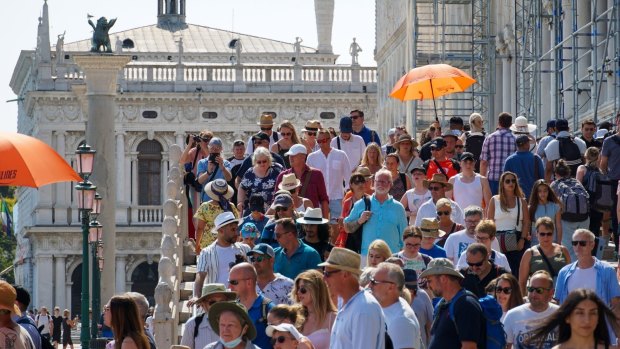This was published 1 year ago
Overtourism and tourist entry fees: The destinations charging visitors to sightsee

Bhutan's famous Tiger's Nest monastery.Credit: Kardd
Wedged into the mountainous folds between India and China, Bhutan is a special brew. It's Shangri-la incarnate, the last Himalayan Buddhist kingdom, a high, misty, sequestered world of chanting monks and monasteries perched among mountain peaks, where the Gross National Happiness index takes the place of Gross Domestic Product as the yardstick of national achievement.
Bhutan protects its unique cultural and natural heritage with a policy of high value, low volume tourism that requires a minimum daily spend from visitors, and it's just tightened the screws. Bhutan has upped its mandatory Sustainability Development Fee (SDF) for foreign visitors from $US65 ($A94) to $US200 ($290) per day. That will bring the daily fee that foreigners must pay to $US335-$US385 ($485-$558) depending on the season, however that does cover the cost of transport, food, accommodation and a guide.
The move has caused alarm bells to ring in the tourism industry. Sydney-based World Expeditions, which has been operating tours to Bhutan for more than a decade, has been lobbying for a restructure of the SDF based on the time travellers spend in Bhutan. According to a World Expeditions spokesperson, "On average, our customers spend a minimum of two and up to four weeks in country. Since trekking expeditions have a longer duration World Expeditions is very concerned that the increase will have a major impact on trekking in Bhutan. One of our most popular treks is the 27-day Bhutan Snowman trek. The price rise means clients will now pay almost $17,000, rather than the current cost of $11,190. While Bhutan offers a rich experience, it stands to become a destination for only the wealthy, at odds with the ideology of inclusive and sustainable tourism."

Tourists walk on the Ponte della Paglia historic footbridge in Venice, Italy. The city has introduced an entry fee for daytrippers.Credit: Getty Images
However not every foreign visitor pays the same fees. Instead of the newly risen $US200 ($290) Sustainable Development Fee, Indian, Bangladeshi and Maldivian passport holders will continue to pay an SDF of 1200 rupees ($22) per day. That was only introduced in July 2020, before there was no SDF for visitors from the subcontinent. Nor do they pay the minimum daily package charge of $US135-185 ($195-268) per day for food, transport and accommodation on top of the SDF. A group of Indians or Bangladeshis travelling together pay local operators direct for these goods and services, which might add around INR2000 ($36) per day to the SDF. The same package for which a non-subcontinental visitor is paying around eight times more.
In 2019, of the 315,000 foreigners who visited Bhutan, more than three-quarters were from India or Bangladesh. There's a risk that the vastly increased SDF will squeeze out the high fee-paying tourists not from the Indian subcontinent while the numbers of Indian and Bangladeshi tourists remains constant, or even increases to fill the void. As well as hobbling the country's tourism industry as it struggles to recover after two years of inactivity, the increased SDF challenges the credibility of Bhutan's high value, low volume tourism ethos.
Are access fees the solution to overtourism?
Access fees work. That was proven to me at Chand Baori stepwell in India's Rajasthan. This is the mother of all Indian stepwells, 13-storeys of stone terraces linked by staircases descending to the pool at the bottom, like an upside-down step pyramid plumbed into the earth. In 2016, when I first visited, there were less than half a dozen visitors admiring this wonder. Admission was free, you just wandered in. Soon after, Chand Baori was "discovered". In 2018 the street in front of the stepwell was packed with tour buses. More than 200 foreign tourists were walking around the stepwell's top terrace. A year after that the scene was transformed. Local authorities had imposed an admission charge of 300 rupees ($5.40), and Chand Baori was gone from the tour bus circuit.
Venice is also imposing an access charge, though on a far more modest scale than Bhutan's. In this case it's also selective, aimed squarely at the huge number of day-trippers who visit the city – almost 20 million in 2019. Those visitors contribute little to the city's tourism industry, yet they pack into St Mark's Square, clog the bridges and a small but annoying number get up the noses of the locals.
From mid-January 2023, Venice will impose a day-visitor entry fee of €3-10 ($4.50-15) depending on the season. The aim is to deter day-trippers rather than to plump up the city's coffers. That's a modest fee, but since most of those day trippers are Italian, the city authorities may be treading cautiously. There are plenty of galleries and museums throughout Italy that charge more than that, however once introduced, it's easy to increase the charge until it has the desired effect.
An entry fee is simple in the case of Venice. Most visitors will arrive by train or motor vehicle across the causeway and therefore it's easy to install a gatekeeper to make sure they've paid before boarding a ferry onto the island.
A pay-for-entry system could work in Dubrovnik, another city plagued by overtourism. Known as the "Pearl of the Adriatic", the walled city was a shoo-in for a place on the World Heritage list. As well as winning the city a starring role as King's Landing in the Game of Thrones series, Dubrovnik's Baroque churches, stone staircases, fountains and squares have made it a favourite on the cruise circuit. In 2016, UNESCO warned that the pressure of visitor numbers was putting the city's World Heritage status at risk, recommending the city restrict visitor numbers to 8000 per day. Cruise operators have agreed to limit the number of vessels to two per day, with a combined maximum of 5000 passengers. At the moment that has clamped visitor numbers within manageable levels, although Croatia's tourism industry is yet to recover to pre-pandemic numbers.
Amsterdam is another city that suffers the blight of being loved to death. The Netherlands capital has taken a different approach, tailoring the kind of tourists it attracts by cauterising some of its libertarian attractions. As well as banning landlords from renting out properties in the city centre on Airbnb and other accommodation platforms, the city plans to relocate is infamous red-light district to its outskirts. Another initiative in a suite of moves designed to limit the city's appeal to the kind of tourists it really doesn't want, Amsterdam's mayor is pushing to ban coffee shops from selling cannabis products to tourists. Those deprived could always head for Bhutan instead, it grows wild and free, although consumption could land you in a very un-Shangri-la Bhutanese jail.
Sign up for the Traveller newsletter
The latest travel news, tips and inspiration delivered to your inbox. Sign up now.